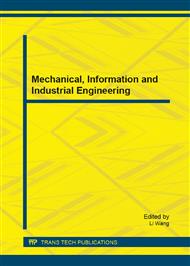p.191
p.196
p.201
p.206
p.211
p.218
p.225
p.229
p.234
An Optimization Method for Solution Selection Based on the Inverse Kinematics Problem of a Mechanical Arm
Abstract:
The solution selection problem of inverse kinematics for a mechanical arm is an important factor affecting the robot end effector positioning. This paper takes a real robotic arm of four degrees of freedom grasping the target object as the research background and studies the multi-solution problem of the inverse kinematics. Firstly, the paper establishes the kinematics model of the mechanical arm and solved the inverse kinematics equation by multiplying by the inverse of the coordinate transformation matrix on both sides. Secondly, the paper presents an optimization method based on joint minimization aiming at the multi-solution problem, and deals with the singularity of the mechanical arm by using the method of setting threshold in the process of operation, which can get the optimal solution without suffering singularity problems. Finally, the simulation and experiment results show that the joint angle of the mechanical arm changes smoothly during the operation process and singular points do not occur, verifying the effectiveness of the processing method.
Info:
Periodical:
Pages:
211-217
Citation:
Online since:
March 2015
Authors:
Keywords:
Price:
Сopyright:
© 2015 Trans Tech Publications Ltd. All Rights Reserved
Share:
Citation:


